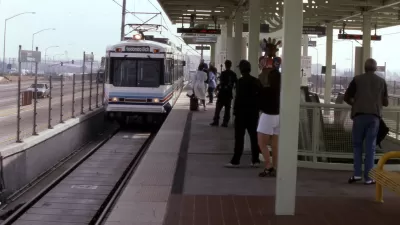After a weekend in which Los Angeles successfully navigated the closure of one of its most clogged freeways once again, we look back at the disastrous effect that freeway construction had on L.A.'s communities during the middle of the last century.
Carmageddon II went off without a hitch this past weekend, as Angelenos easily adjusted their schedules and transportation plans to avoid the closure of a crucial stretch of the San Diego Freeway and celebrated their local communities. However, for three decades in the middle of the last century, and with repercussions ever since, the process by which the Santa Monica Freeway was planned and constructed tore apart L.A.'s neighborhoods. Nathan Masters traces the planning and construction of the I-10 Freeway, "an indelible marker across the Los
Angeles landscape, a mini-equator that delineates boundaries between
cultural and historical hemispheres of the city," segregating the affluent north of the city from the disadvantaged south.
Constructed as part of L.A.'s second generation of freeways, the I-10 was built as "part of a broader statewide and national effort."
"With this backing," says Masters, "came bolder plans and a tendency to subordinate local
concerns to the needs of the larger region. Mapping their proposed
routes, planners drew lines straight through established residential
communities. Houses and local businesses along the route were no more an
obstacle than existing surface streets or water mains; the state would
purchase whatever property it needed, relocate residents, and
reconfigure the neighborhoods around the new freeway."
FULL STORY: Creating the Santa Monica Freeway, Building Walls Across Communities

Alabama: Trump Terminates Settlements for Black Communities Harmed By Raw Sewage
Trump deemed the landmark civil rights agreement “illegal DEI and environmental justice policy.”

Planetizen Federal Action Tracker
A weekly monitor of how Trump’s orders and actions are impacting planners and planning in America.

Why Should We Subsidize Public Transportation?
Many public transit agencies face financial stress due to rising costs, declining fare revenue, and declining subsidies. Transit advocates must provide a strong business case for increasing public transit funding.

Understanding Road Diets
An explainer from Momentum highlights the advantages of reducing vehicle lanes in favor of more bike, transit, and pedestrian infrastructure.

New California Law Regulates Warehouse Pollution
A new law tightens building and emissions regulations for large distribution warehouses to mitigate air pollution and traffic in surrounding communities.

Phoenix Announces Opening Date for Light Rail Extension
The South Central extension will connect South Phoenix to downtown and other major hubs starting on June 7.
Urban Design for Planners 1: Software Tools
This six-course series explores essential urban design concepts using open source software and equips planners with the tools they need to participate fully in the urban design process.
Planning for Universal Design
Learn the tools for implementing Universal Design in planning regulations.
Caltrans
Smith Gee Studio
Institute for Housing and Urban Development Studies (IHS)
City of Grandview
Harvard GSD Executive Education
Toledo-Lucas County Plan Commissions
Salt Lake City
NYU Wagner Graduate School of Public Service




























